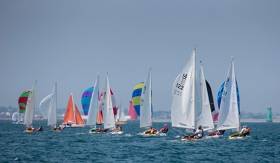Displaying items by tag: Fiachra Collins
IDRA 14 Northern Championships Held at 'Roastrevor'
June bank holiday weekend now features a joyous experience every year – driving down the main street in Warrenpoint, boat jangling on trailer behind, to emerge to the glorious panoramic vista of Carlingford Lough. A few miles further along the road to Rostrevor and Carlingford Lough Yacht Club welcomed the IDRA14 fleet for the 21st occasion spanning 20 years. Dubbed ‘Roastrevor’ this year, we were treated to stunning weather, warm sunshine and fresh sea-breezes.
This year being the 70th anniversary, the IDRA14 ethos of “Classic & Progressive” was very much in evidence, with classic wooden boats looking lustrous (SDC’s Alan Carr’s ever immaculate 14/38 “Starfish” and CYBC’s Donal Heney’s resplendent 14/71 “Atomic”) and a variety of new controls (some new spinnaker pole arrangements, some trying centre-sheeting for example) implemented across the fleet. With a decent turn-out of nine boats, the sailing promised to be good. And of course there was a big turn-out of friends, family, kids and dogs ashore, so spirits were high as the sun was soaked in, BBQs lit and pints were savoured.
Day 1 featured light winds with a clear divide amongst the fleet, with 134 taking two firsts and 38 and 140 swapping second/third for both races. Further back, the competition was tight in battling for best positions. Clontarf’s Ian Sargent and Dave Tillotson assisted in being Race Officer and Rescue on the day.
A strengthening breeze picked up for Day 2, as evidenced by four boats capsizing throughout the first race. For Race 3, a pin bias seemed apparent with both 134 and 142 starting on a port tack and slipped ahead of any oncoming boat on starboard. The windward mark was rounded first by 134, then 38, 142, and followed closely by 140 and 126. Close quarters sailing with the spinnakers aloft, but 142 tipped over following a gybe near the leeward mark. Both 160 and 71 slipped by, having both recovered rapidly from earlier capsizes.
The long race to Warrenpoint started promptly thereafter. 14/142, now drained post-capsize, again took a port start and executed a rapid tack in advance of the hollering starboard boats. After a short upwind leg, the windward mark was rounded in order of 134, 38, 142, 140, 126, 160 and 71. Sweeping around the mark, bows were pointed towards the steeple in Warrenpoint and the then invisible mark approximately three miles distant. Spinnakers were hoisted, set and filled and the boats surged forward, tearing down the Lough in chase of the local club Lasers starting earlier. At a broad reach, near run, the boats surfed down the waves rolling up the Lough. 134 extended their lead and 140 slipped into third place, with 142 and 126 rounding the leeward mark in close pursuit. Hardening up into the long beat back, 142 opted for the outer route into the middle of the lough while 140 and 126 tacked back inland. The finish line was out of sight, with just the mast of a giant moored trimaran being a reference point in the hazy sunshine. Crews leaning far out on trapeze, helms hiking over the side, everything stretched to keep the boat flat and slicing through the oncoming swell. With the fleet dispersed, it was difficult to gauge relative progress, with both 134 and 142 opting to sail slightly higher courses to allow to reach at speed for the line. With a clean sweep for the weekend, 134 crossed the line in first place followed a minute later by 38. Both 142 and 140 courses converged towards the line with the tiniest of margins separating them – 142 took 3rd place with 140 crossing 4 seconds later. 126, 160 and 71 took the remaining positions after a tough close-hauled sail up the lough.
Alan Henry / Simon Revill (14/134) of Sutton Dinghy Club claimed first place, with Alan Carr / Dana Kilroy (14/38) also of Sutton Dinghy Club in second place and Frank Hamilton / Jennifer Byrne (14/140) of Dun Laoghaire Motor Yacht Club in third place. Proving that blood is indeed thicker than water, Charles Sargent and granddaughter Caoimhe Fleming (14/126) of Sutton Dinghy Club took home the Warrenpoint trophy on handicap. Overall a fantastic weekend of superb sailing conditions, fabulous weather and relaxing atmosphere, all graciously hosted with thanks to good folks in Carlingford Lough Yacht Club.





























































